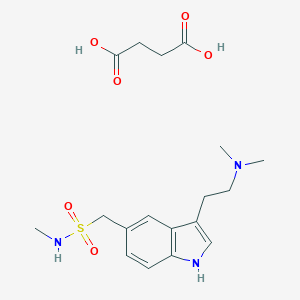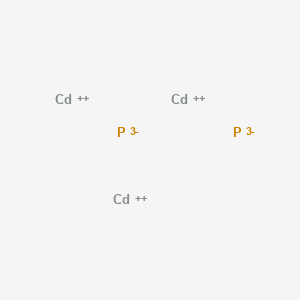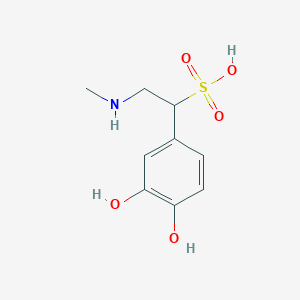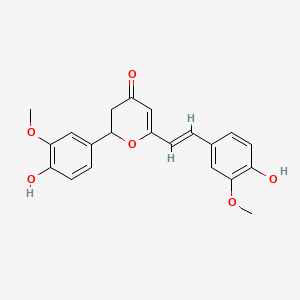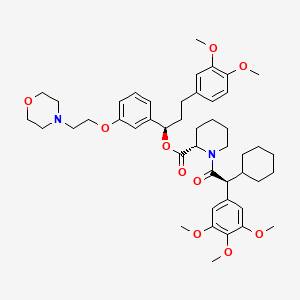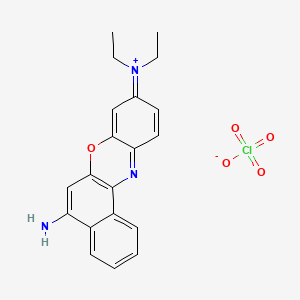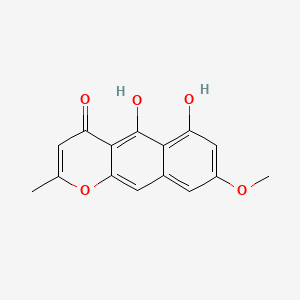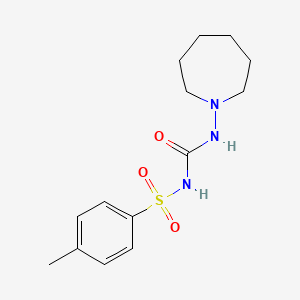
Tolazamide
Vue d'ensemble
Description
Tolazamide is an oral blood glucose-lowering drug used primarily for the treatment of Type 2 diabetes mellitus. It belongs to the sulfonylurea class of medications, which function by stimulating the release of insulin from the pancreas. This compound is particularly effective in patients whose hyperglycemia cannot be controlled by diet alone .
Méthodes De Préparation
Synthetic Routes and Reaction Conditions: Tolazamide is synthesized through a multi-step process. The synthesis begins with the conversion of para-toluenesulfonamide to its carbamate using ethyl chloroformate in the presence of a base. This intermediate is then heated with 1-amino-azepane, leading to the displacement of the ethoxy group and the formation of this compound .
Industrial Production Methods: In industrial settings, the production of this compound involves similar synthetic routes but on a larger scale. The process is optimized for yield and purity, ensuring that the final product meets pharmaceutical standards. The reaction conditions are carefully controlled to maintain consistency and efficiency .
Analyse Des Réactions Chimiques
Types of Reactions: Tolazamide undergoes various chemical reactions, including:
Oxidation: this compound can be oxidized under specific conditions, leading to the formation of sulfoxides and sulfones.
Reduction: Reduction reactions can convert this compound to its corresponding amine derivatives.
Substitution: this compound can undergo nucleophilic substitution reactions, particularly at the sulfonylurea moiety.
Common Reagents and Conditions:
Oxidation: Common oxidizing agents include hydrogen peroxide and potassium permanganate.
Reduction: Reducing agents such as lithium aluminum hydride and sodium borohydride are used.
Substitution: Nucleophiles like amines and thiols are commonly employed in substitution reactions.
Major Products: The major products formed from these reactions include sulfoxides, sulfones, amine derivatives, and substituted sulfonylureas .
Applications De Recherche Scientifique
Tolazamide has a wide range of scientific research applications:
Chemistry: It is used as a model compound in studies of sulfonylurea chemistry and reaction mechanisms.
Biology: this compound is studied for its effects on cellular metabolism and insulin secretion.
Medicine: It is extensively researched for its therapeutic potential in managing Type 2 diabetes mellitus.
Industry: this compound is used in the pharmaceutical industry for the development of new antidiabetic drugs.
Mécanisme D'action
Tolazamide lowers blood glucose levels by stimulating the release of insulin from the pancreas. This effect is dependent on functioning beta cells in the pancreatic islets. The compound binds to ATP-sensitive potassium-channel receptors on the pancreatic cell surface, reducing potassium conductance and causing depolarization of the membrane. This depolarization triggers the opening of voltage-gated calcium channels, leading to an influx of calcium ions and subsequent insulin release .
Comparaison Avec Des Composés Similaires
- Chlorpropamide
- Glipizide
- Glyburide
- Glimepiride
Comparison: Tolazamide is unique among sulfonylureas due to its specific pharmacokinetic properties, including its relatively long half-life and its ability to produce a mild diuretic effect by enhancing renal free water clearance. Compared to other sulfonylureas, this compound has a more gradual onset of action and a longer duration of effect, making it suitable for patients who require sustained blood glucose control .
Activité Biologique
Tolazamide is an oral hypoglycemic agent belonging to the sulfonylurea class, primarily used in the management of Type 2 diabetes mellitus. It functions by stimulating insulin release from pancreatic beta cells and has various biological effects that impact glucose metabolism and insulin dynamics. This article delves into the biological activity of this compound, supported by research findings, data tables, and case studies.
This compound lowers blood glucose levels primarily through the following mechanisms:
- Insulin Secretion : It stimulates the release of insulin from functioning beta cells in the pancreas. This effect is contingent upon the presence of functional pancreatic islets.
- Extrapancreatic Effects : Over time, this compound may exert additional effects beyond insulin secretion, as its efficacy can persist even with a decline in insulin response .
The drug binds to ATP-sensitive potassium channels on pancreatic cells, leading to membrane depolarization and subsequent calcium influx that triggers insulin exocytosis.
Pharmacokinetics
- Absorption : Rapidly absorbed from the gastrointestinal tract.
- Metabolism : Metabolized into five major metabolites, which exhibit varying degrees of hypoglycemic activity.
- Elimination : Primarily excreted through urine .
Gluconeogenesis and Ketogenesis
Research indicates that this compound can significantly inhibit gluconeogenesis and ketogenesis in liver tissues. A study demonstrated that at therapeutic concentrations (40 µg/ml), this compound reduced ketogenesis by 39% in diabetic livers and 32% in control livers. Additionally, it curtailed hepatic gluconeogenesis by 74% in control liver tissue .
Binding Characteristics
This compound exhibits dual binding sites on human serum albumin (HSA) with high and low affinity. Frontal analysis studies have shown that it binds effectively to both normal and glycated HSA, with non-specific binding ranging from 27% to 36% . This binding characteristic may influence its pharmacokinetic profile and therapeutic effectiveness.
Clinical Studies
Several clinical studies have evaluated the efficacy of this compound in managing diabetes:
- Postprandial Carbohydrate Metabolism :
- Insulin Action :
- Case Studies of Hypoglycemia :
Data Summary
The following table summarizes key findings related to this compound's biological activity:
Q & A
Basic Research Questions
Q. How to design experiments to assess Tolazamide’s binding affinity to human serum albumin (HSA)?
- Methodology : Use frontal analysis and zonal elution techniques.
- Frontal analysis : Apply stepwise concentrations of this compound (0.5–50 µM) to HSA-immobilized microcolumns. Monitor breakthrough curves via UV detection (254 nm) and fit data to two-site binding models (Eqs. 3–4) to calculate association constants (Ka) and binding site availability .
- Zonal elution : Compete this compound with site-specific probes (e.g., L-tryptophan for Sudlow site II) to determine site-selective binding constants (Table 2 in ). Control columns without HSA correct for non-specific binding .
Q. What experimental approaches characterize this compound’s metabolic pathways in preclinical models?
- Methodology : Administer tritium-labeled this compound and isolate metabolites via chromatography.
- Crystallize metabolites (e.g., hydroxylated derivatives) and confirm structures via single-crystal X-ray diffraction .
- Quantify urinary excretion (85% over 5 days in humans) and compare metabolite profiles between species (e.g., humans vs. rats) to identify interspecies variations .
Q. How to determine crystallization kinetics of this compound for pharmaceutical formulation?
- Methodology : Measure induction times under varying supersaturation levels using turbidity assays.
- Use van der Leeden’s model to differentiate growth mechanisms (e.g., two-dimensional nucleation-mediated growth). Validate with atomic force microscopy (AFM) to visualize crystal surface topography .
Advanced Research Questions
Q. How to resolve contradictions in this compound’s binding data between normal and glycated HSA?
- Methodology : Apply two-site binding models (Eq. 4) for frontal analysis data.
- Glycation alters Ka1 (moderate-to-high affinity sites) by -19% to +13% and increases Ka2 (low-affinity sites) 1.7–1.9-fold. Use statistical criteria (sum of squares residuals, correlation coefficients >0.9998) to validate model superiority over one-site models .
- Compare with prior sulfonylurea data (e.g., chlorpropamide’s 55% affinity increase on glycated HSA) to contextualize trends .
Q. What computational and experimental methods characterize this compound’s polymorphic forms?
- Methodology : Combine single-crystal/powder XRD , DSC , and DFT calculations .
- Identify isoenergetic polymorphs (Forms I and II) with irreversible thermal transitions. Analyze lattice energy differences (<1 kcal/mol) to explain kinetic stability despite similar thermodynamics .
- Use high-pressure studies (methanol or pentane-isopentane as pressure-transmitting fluids) to probe phase transitions and compressibility anisotropy .
Q. How to design clinical trials assessing this compound as adjuvant therapy with insulin?
- Methodology : Implement double-blind crossover studies with rigorous endpoints.
- Measure fasting plasma glucose (FPG), HbA1c, and C-peptide levels. For example, this compound + insulin reduced FPG from 10.8 to 6.7 mmol/L in type I diabetes, with dose adjustments for renal impairment (85% urinary excretion) .
- Use washout periods to confirm reversibility of metabolic effects upon this compound withdrawal .
Q. What strategies compare this compound’s binding behavior to other sulfonylureas?
- Methodology : Perform competitive zonal elution with shared probes (e.g., warfarin for Sudlow site I).
- Compare Ka values: this compound’s Sudlow site II affinity (1.9–3.0 × 10⁴ M⁻¹) is lower than acetohexamide but higher than tolbutamide. Relate structural differences (e.g., R1/R2 substituents) to binding trends .
- Normalize data to HSA activity (0.16 mol binding sites/mol HSA) to account for immobilized protein variability .
Q. Data Analysis and Contradiction Management
Q. How to interpret discrepancies in binding constants across studies?
- Methodology : Standardize experimental conditions (e.g., pH 7.4 buffer, 0.067 M ionic strength) and validate HSA immobilization efficiency (41–45 nmol/column).
- Use PeakFit software to precisely locate breakthrough curves and minimize system void time artifacts .
- Reconcile Ka1 values (4.3–6.0 × 10⁴ M⁻¹) with prior sulfonylurea studies by adjusting for glycation levels (e.g., gHSA1 vs. gHSA2) .
Q. How to address kinetic vs. thermodynamic control in this compound polymorphism?
- Methodology : Conduct low-temperature XRD and DFT-based enthalpy calculations .
- Despite Form I’s thermodynamic stability, Form II dominates under rapid crystallization due to faster nucleation. Use AFM to correlate growth mechanisms (e.g., spiral growth patterns) with kinetic preferences .
Q. Tables
Table 1. Binding Constants of this compound on HSA (Frontal Analysis)
| HSA Type | Ka1 (×10⁴ M⁻¹) | Ka2 (×10³ M⁻¹) | mL1 (mol/mol HSA) | mL2 (mol/mol HSA) |
|---|---|---|---|---|
| Normal HSA | 6.0 ± 0.1 | 4.9 ± 0.2 | 0.19 | 3.9 |
| Glycated HSA (gHSA1) | 4.3 ± 0.1 | 9.1 ± 0.3 | 0.14 | 19.6 |
| Glycated HSA (gHSA2) | 6.8 ± 0.2 | 8.7 ± 0.2 | 0.16 | 18.3 |
| Source: Adapted from Table 1 in . |
Table 2. Site-Specific Binding Constants (Zonal Elution)
| HSA Type | Sudlow Site I (×10³ M⁻¹) | Sudlow Site II (×10⁴ M⁻¹) |
|---|---|---|
| Normal HSA | 2.1 ± 0.3 | 2.5 ± 0.4 |
| Glycated HSA | 1.6 ± 0.2 (-22%) | 3.0 ± 0.5 (+58%) |
| Source: . |
Propriétés
IUPAC Name |
1-(azepan-1-yl)-3-(4-methylphenyl)sulfonylurea | |
|---|---|---|
| Source | PubChem | |
| URL | https://pubchem.ncbi.nlm.nih.gov | |
| Description | Data deposited in or computed by PubChem | |
InChI |
InChI=1S/C14H21N3O3S/c1-12-6-8-13(9-7-12)21(19,20)16-14(18)15-17-10-4-2-3-5-11-17/h6-9H,2-5,10-11H2,1H3,(H2,15,16,18) | |
| Source | PubChem | |
| URL | https://pubchem.ncbi.nlm.nih.gov | |
| Description | Data deposited in or computed by PubChem | |
InChI Key |
OUDSBRTVNLOZBN-UHFFFAOYSA-N | |
| Source | PubChem | |
| URL | https://pubchem.ncbi.nlm.nih.gov | |
| Description | Data deposited in or computed by PubChem | |
Canonical SMILES |
CC1=CC=C(C=C1)S(=O)(=O)NC(=O)NN2CCCCCC2 | |
| Source | PubChem | |
| URL | https://pubchem.ncbi.nlm.nih.gov | |
| Description | Data deposited in or computed by PubChem | |
Molecular Formula |
C14H21N3O3S | |
| Record name | TOLAZAMIDE | |
| Source | CAMEO Chemicals | |
| URL | https://cameochemicals.noaa.gov/chemical/21119 | |
| Description | CAMEO Chemicals is a chemical database designed for people who are involved in hazardous material incident response and planning. CAMEO Chemicals contains a library with thousands of datasheets containing response-related information and recommendations for hazardous materials that are commonly transported, used, or stored in the United States. CAMEO Chemicals was developed by the National Oceanic and Atmospheric Administration's Office of Response and Restoration in partnership with the Environmental Protection Agency's Office of Emergency Management. | |
| Explanation | CAMEO Chemicals and all other CAMEO products are available at no charge to those organizations and individuals (recipients) responsible for the safe handling of chemicals. However, some of the chemical data itself is subject to the copyright restrictions of the companies or organizations that provided the data. | |
| Source | PubChem | |
| URL | https://pubchem.ncbi.nlm.nih.gov | |
| Description | Data deposited in or computed by PubChem | |
DSSTOX Substance ID |
DTXSID3021358 | |
| Record name | Tolazamide | |
| Source | EPA DSSTox | |
| URL | https://comptox.epa.gov/dashboard/DTXSID3021358 | |
| Description | DSSTox provides a high quality public chemistry resource for supporting improved predictive toxicology. | |
Molecular Weight |
311.40 g/mol | |
| Source | PubChem | |
| URL | https://pubchem.ncbi.nlm.nih.gov | |
| Description | Data deposited in or computed by PubChem | |
Physical Description |
Tolazamide appears as white to off-white crystalline powder. Odorless or with a slight odor. (NTP, 1992), Solid | |
| Record name | TOLAZAMIDE | |
| Source | CAMEO Chemicals | |
| URL | https://cameochemicals.noaa.gov/chemical/21119 | |
| Description | CAMEO Chemicals is a chemical database designed for people who are involved in hazardous material incident response and planning. CAMEO Chemicals contains a library with thousands of datasheets containing response-related information and recommendations for hazardous materials that are commonly transported, used, or stored in the United States. CAMEO Chemicals was developed by the National Oceanic and Atmospheric Administration's Office of Response and Restoration in partnership with the Environmental Protection Agency's Office of Emergency Management. | |
| Explanation | CAMEO Chemicals and all other CAMEO products are available at no charge to those organizations and individuals (recipients) responsible for the safe handling of chemicals. However, some of the chemical data itself is subject to the copyright restrictions of the companies or organizations that provided the data. | |
| Record name | Tolazamide | |
| Source | Human Metabolome Database (HMDB) | |
| URL | http://www.hmdb.ca/metabolites/HMDB0014977 | |
| Description | The Human Metabolome Database (HMDB) is a freely available electronic database containing detailed information about small molecule metabolites found in the human body. | |
| Explanation | HMDB is offered to the public as a freely available resource. Use and re-distribution of the data, in whole or in part, for commercial purposes requires explicit permission of the authors and explicit acknowledgment of the source material (HMDB) and the original publication (see the HMDB citing page). We ask that users who download significant portions of the database cite the HMDB paper in any resulting publications. | |
Solubility |
less than 1 mg/mL at 77 °F (NTP, 1992), VERY SLIGHTLY SOL IN WATER; FREELY SOL IN CHLOROFORM; SOL IN ACETONE; SIGHTLY SOL IN ALCOHOL, In water, 65.4 mg/l @ 30 °C, 3.08e-01 g/L | |
| Record name | TOLAZAMIDE | |
| Source | CAMEO Chemicals | |
| URL | https://cameochemicals.noaa.gov/chemical/21119 | |
| Description | CAMEO Chemicals is a chemical database designed for people who are involved in hazardous material incident response and planning. CAMEO Chemicals contains a library with thousands of datasheets containing response-related information and recommendations for hazardous materials that are commonly transported, used, or stored in the United States. CAMEO Chemicals was developed by the National Oceanic and Atmospheric Administration's Office of Response and Restoration in partnership with the Environmental Protection Agency's Office of Emergency Management. | |
| Explanation | CAMEO Chemicals and all other CAMEO products are available at no charge to those organizations and individuals (recipients) responsible for the safe handling of chemicals. However, some of the chemical data itself is subject to the copyright restrictions of the companies or organizations that provided the data. | |
| Record name | Tolazamide | |
| Source | DrugBank | |
| URL | https://www.drugbank.ca/drugs/DB00839 | |
| Description | The DrugBank database is a unique bioinformatics and cheminformatics resource that combines detailed drug (i.e. chemical, pharmacological and pharmaceutical) data with comprehensive drug target (i.e. sequence, structure, and pathway) information. | |
| Explanation | Creative Common's Attribution-NonCommercial 4.0 International License (http://creativecommons.org/licenses/by-nc/4.0/legalcode) | |
| Record name | TOLAZAMIDE | |
| Source | Hazardous Substances Data Bank (HSDB) | |
| URL | https://pubchem.ncbi.nlm.nih.gov/source/hsdb/3192 | |
| Description | The Hazardous Substances Data Bank (HSDB) is a toxicology database that focuses on the toxicology of potentially hazardous chemicals. It provides information on human exposure, industrial hygiene, emergency handling procedures, environmental fate, regulatory requirements, nanomaterials, and related areas. The information in HSDB has been assessed by a Scientific Review Panel. | |
| Record name | Tolazamide | |
| Source | Human Metabolome Database (HMDB) | |
| URL | http://www.hmdb.ca/metabolites/HMDB0014977 | |
| Description | The Human Metabolome Database (HMDB) is a freely available electronic database containing detailed information about small molecule metabolites found in the human body. | |
| Explanation | HMDB is offered to the public as a freely available resource. Use and re-distribution of the data, in whole or in part, for commercial purposes requires explicit permission of the authors and explicit acknowledgment of the source material (HMDB) and the original publication (see the HMDB citing page). We ask that users who download significant portions of the database cite the HMDB paper in any resulting publications. | |
Mechanism of Action |
Sulfonylureas likely bind to ATP-sensitive potassium-channel receptors on the pancreatic cell surface, reducing potassium conductance and causing depolarization of the membrane. Depolarization stimulates calcium ion influx through voltage-sensitive calcium channels, raising intracellular concentrations of calcium ions, which induces the secretion, or exocytosis, of insulin., Sulfonylureas are now...thought to act by a number of different mechanisms. 1. ...produce a depolarization of the pancreatic islet beta cell membrane potassium ion permeability. This results in a release of preformed insulin into the circulation and occurs mostly in non-insulin dependent diabetics. 2. ...reduce basal glucose output from the liver... 3. increase insulin receptor binding... 4. ...increasing intracellular levels of AMP... 5. increase insulin secretion by suppressing the release of glucagon and somatostatin from alpha and delta pancreatic cells. /Sulfonylureas/, Sulfonylureas lower blood glucose in NIDDM by directly stimulating the acute release of insulin from functioning beta cells of pancreatic islet tissue by an unknown process that involves a sulfonylurea receptor on the beta cell. Sulfonylureas inhibit the ATP potassium channels on the beta cell membrane and potassium efflux, which results in depolarization and calcium influx, calcium-calmodulin binding, kinase activation, and release of insulin containing granules by exocytosis, an effect similar to that of glucose. Insulin is a hormone that lowers blood glucose and controls the storage and metabolism of carbohydrates, proteins, and fats. Therefore, sulfonylureas are effective only in patients whose pancreata are capable of producing insulin. /Sulfonylurea antidiabetic agents/ | |
| Record name | Tolazamide | |
| Source | DrugBank | |
| URL | https://www.drugbank.ca/drugs/DB00839 | |
| Description | The DrugBank database is a unique bioinformatics and cheminformatics resource that combines detailed drug (i.e. chemical, pharmacological and pharmaceutical) data with comprehensive drug target (i.e. sequence, structure, and pathway) information. | |
| Explanation | Creative Common's Attribution-NonCommercial 4.0 International License (http://creativecommons.org/licenses/by-nc/4.0/legalcode) | |
| Record name | TOLAZAMIDE | |
| Source | Hazardous Substances Data Bank (HSDB) | |
| URL | https://pubchem.ncbi.nlm.nih.gov/source/hsdb/3192 | |
| Description | The Hazardous Substances Data Bank (HSDB) is a toxicology database that focuses on the toxicology of potentially hazardous chemicals. It provides information on human exposure, industrial hygiene, emergency handling procedures, environmental fate, regulatory requirements, nanomaterials, and related areas. The information in HSDB has been assessed by a Scientific Review Panel. | |
Color/Form |
Crystals, WHITE TO OFF-WHITE, CRYSTALLINE POWDER | |
CAS No. |
1156-19-0 | |
| Record name | TOLAZAMIDE | |
| Source | CAMEO Chemicals | |
| URL | https://cameochemicals.noaa.gov/chemical/21119 | |
| Description | CAMEO Chemicals is a chemical database designed for people who are involved in hazardous material incident response and planning. CAMEO Chemicals contains a library with thousands of datasheets containing response-related information and recommendations for hazardous materials that are commonly transported, used, or stored in the United States. CAMEO Chemicals was developed by the National Oceanic and Atmospheric Administration's Office of Response and Restoration in partnership with the Environmental Protection Agency's Office of Emergency Management. | |
| Explanation | CAMEO Chemicals and all other CAMEO products are available at no charge to those organizations and individuals (recipients) responsible for the safe handling of chemicals. However, some of the chemical data itself is subject to the copyright restrictions of the companies or organizations that provided the data. | |
| Record name | Tolazamide | |
| Source | CAS Common Chemistry | |
| URL | https://commonchemistry.cas.org/detail?cas_rn=1156-19-0 | |
| Description | CAS Common Chemistry is an open community resource for accessing chemical information. Nearly 500,000 chemical substances from CAS REGISTRY cover areas of community interest, including common and frequently regulated chemicals, and those relevant to high school and undergraduate chemistry classes. This chemical information, curated by our expert scientists, is provided in alignment with our mission as a division of the American Chemical Society. | |
| Explanation | The data from CAS Common Chemistry is provided under a CC-BY-NC 4.0 license, unless otherwise stated. | |
| Record name | Tolazamide [USAN:USP:INN:BAN:JAN] | |
| Source | ChemIDplus | |
| URL | https://pubchem.ncbi.nlm.nih.gov/substance/?source=chemidplus&sourceid=0001156190 | |
| Description | ChemIDplus is a free, web search system that provides access to the structure and nomenclature authority files used for the identification of chemical substances cited in National Library of Medicine (NLM) databases, including the TOXNET system. | |
| Record name | Tolazamide | |
| Source | DrugBank | |
| URL | https://www.drugbank.ca/drugs/DB00839 | |
| Description | The DrugBank database is a unique bioinformatics and cheminformatics resource that combines detailed drug (i.e. chemical, pharmacological and pharmaceutical) data with comprehensive drug target (i.e. sequence, structure, and pathway) information. | |
| Explanation | Creative Common's Attribution-NonCommercial 4.0 International License (http://creativecommons.org/licenses/by-nc/4.0/legalcode) | |
| Record name | tolazamide | |
| Source | DTP/NCI | |
| URL | https://dtp.cancer.gov/dtpstandard/servlet/dwindex?searchtype=NSC&outputformat=html&searchlist=758149 | |
| Description | The NCI Development Therapeutics Program (DTP) provides services and resources to the academic and private-sector research communities worldwide to facilitate the discovery and development of new cancer therapeutic agents. | |
| Explanation | Unless otherwise indicated, all text within NCI products is free of copyright and may be reused without our permission. Credit the National Cancer Institute as the source. | |
| Record name | tolazamide | |
| Source | DTP/NCI | |
| URL | https://dtp.cancer.gov/dtpstandard/servlet/dwindex?searchtype=NSC&outputformat=html&searchlist=70762 | |
| Description | The NCI Development Therapeutics Program (DTP) provides services and resources to the academic and private-sector research communities worldwide to facilitate the discovery and development of new cancer therapeutic agents. | |
| Explanation | Unless otherwise indicated, all text within NCI products is free of copyright and may be reused without our permission. Credit the National Cancer Institute as the source. | |
| Record name | Tolazamide | |
| Source | EPA DSSTox | |
| URL | https://comptox.epa.gov/dashboard/DTXSID3021358 | |
| Description | DSSTox provides a high quality public chemistry resource for supporting improved predictive toxicology. | |
| Record name | Tolazamide | |
| Source | European Chemicals Agency (ECHA) | |
| URL | https://echa.europa.eu/substance-information/-/substanceinfo/100.013.262 | |
| Description | The European Chemicals Agency (ECHA) is an agency of the European Union which is the driving force among regulatory authorities in implementing the EU's groundbreaking chemicals legislation for the benefit of human health and the environment as well as for innovation and competitiveness. | |
| Explanation | Use of the information, documents and data from the ECHA website is subject to the terms and conditions of this Legal Notice, and subject to other binding limitations provided for under applicable law, the information, documents and data made available on the ECHA website may be reproduced, distributed and/or used, totally or in part, for non-commercial purposes provided that ECHA is acknowledged as the source: "Source: European Chemicals Agency, http://echa.europa.eu/". Such acknowledgement must be included in each copy of the material. ECHA permits and encourages organisations and individuals to create links to the ECHA website under the following cumulative conditions: Links can only be made to webpages that provide a link to the Legal Notice page. | |
| Record name | TOLAZAMIDE | |
| Source | FDA Global Substance Registration System (GSRS) | |
| URL | https://gsrs.ncats.nih.gov/ginas/app/beta/substances/9LT1BRO48Q | |
| Description | The FDA Global Substance Registration System (GSRS) enables the efficient and accurate exchange of information on what substances are in regulated products. Instead of relying on names, which vary across regulatory domains, countries, and regions, the GSRS knowledge base makes it possible for substances to be defined by standardized, scientific descriptions. | |
| Explanation | Unless otherwise noted, the contents of the FDA website (www.fda.gov), both text and graphics, are not copyrighted. They are in the public domain and may be republished, reprinted and otherwise used freely by anyone without the need to obtain permission from FDA. Credit to the U.S. Food and Drug Administration as the source is appreciated but not required. | |
| Record name | TOLAZAMIDE | |
| Source | Hazardous Substances Data Bank (HSDB) | |
| URL | https://pubchem.ncbi.nlm.nih.gov/source/hsdb/3192 | |
| Description | The Hazardous Substances Data Bank (HSDB) is a toxicology database that focuses on the toxicology of potentially hazardous chemicals. It provides information on human exposure, industrial hygiene, emergency handling procedures, environmental fate, regulatory requirements, nanomaterials, and related areas. The information in HSDB has been assessed by a Scientific Review Panel. | |
| Record name | Tolazamide | |
| Source | Human Metabolome Database (HMDB) | |
| URL | http://www.hmdb.ca/metabolites/HMDB0014977 | |
| Description | The Human Metabolome Database (HMDB) is a freely available electronic database containing detailed information about small molecule metabolites found in the human body. | |
| Explanation | HMDB is offered to the public as a freely available resource. Use and re-distribution of the data, in whole or in part, for commercial purposes requires explicit permission of the authors and explicit acknowledgment of the source material (HMDB) and the original publication (see the HMDB citing page). We ask that users who download significant portions of the database cite the HMDB paper in any resulting publications. | |
Melting Point |
322 to 336 °F (with decomposition) (NTP, 1992), 170-173 °C, 170 - 173 °C | |
| Record name | TOLAZAMIDE | |
| Source | CAMEO Chemicals | |
| URL | https://cameochemicals.noaa.gov/chemical/21119 | |
| Description | CAMEO Chemicals is a chemical database designed for people who are involved in hazardous material incident response and planning. CAMEO Chemicals contains a library with thousands of datasheets containing response-related information and recommendations for hazardous materials that are commonly transported, used, or stored in the United States. CAMEO Chemicals was developed by the National Oceanic and Atmospheric Administration's Office of Response and Restoration in partnership with the Environmental Protection Agency's Office of Emergency Management. | |
| Explanation | CAMEO Chemicals and all other CAMEO products are available at no charge to those organizations and individuals (recipients) responsible for the safe handling of chemicals. However, some of the chemical data itself is subject to the copyright restrictions of the companies or organizations that provided the data. | |
| Record name | Tolazamide | |
| Source | DrugBank | |
| URL | https://www.drugbank.ca/drugs/DB00839 | |
| Description | The DrugBank database is a unique bioinformatics and cheminformatics resource that combines detailed drug (i.e. chemical, pharmacological and pharmaceutical) data with comprehensive drug target (i.e. sequence, structure, and pathway) information. | |
| Explanation | Creative Common's Attribution-NonCommercial 4.0 International License (http://creativecommons.org/licenses/by-nc/4.0/legalcode) | |
| Record name | TOLAZAMIDE | |
| Source | Hazardous Substances Data Bank (HSDB) | |
| URL | https://pubchem.ncbi.nlm.nih.gov/source/hsdb/3192 | |
| Description | The Hazardous Substances Data Bank (HSDB) is a toxicology database that focuses on the toxicology of potentially hazardous chemicals. It provides information on human exposure, industrial hygiene, emergency handling procedures, environmental fate, regulatory requirements, nanomaterials, and related areas. The information in HSDB has been assessed by a Scientific Review Panel. | |
| Record name | Tolazamide | |
| Source | Human Metabolome Database (HMDB) | |
| URL | http://www.hmdb.ca/metabolites/HMDB0014977 | |
| Description | The Human Metabolome Database (HMDB) is a freely available electronic database containing detailed information about small molecule metabolites found in the human body. | |
| Explanation | HMDB is offered to the public as a freely available resource. Use and re-distribution of the data, in whole or in part, for commercial purposes requires explicit permission of the authors and explicit acknowledgment of the source material (HMDB) and the original publication (see the HMDB citing page). We ask that users who download significant portions of the database cite the HMDB paper in any resulting publications. | |
Retrosynthesis Analysis
AI-Powered Synthesis Planning: Our tool employs the Template_relevance Pistachio, Template_relevance Bkms_metabolic, Template_relevance Pistachio_ringbreaker, Template_relevance Reaxys, Template_relevance Reaxys_biocatalysis model, leveraging a vast database of chemical reactions to predict feasible synthetic routes.
One-Step Synthesis Focus: Specifically designed for one-step synthesis, it provides concise and direct routes for your target compounds, streamlining the synthesis process.
Accurate Predictions: Utilizing the extensive PISTACHIO, BKMS_METABOLIC, PISTACHIO_RINGBREAKER, REAXYS, REAXYS_BIOCATALYSIS database, our tool offers high-accuracy predictions, reflecting the latest in chemical research and data.
Strategy Settings
| Precursor scoring | Relevance Heuristic |
|---|---|
| Min. plausibility | 0.01 |
| Model | Template_relevance |
| Template Set | Pistachio/Bkms_metabolic/Pistachio_ringbreaker/Reaxys/Reaxys_biocatalysis |
| Top-N result to add to graph | 6 |
Feasible Synthetic Routes
Avertissement et informations sur les produits de recherche in vitro
Veuillez noter que tous les articles et informations sur les produits présentés sur BenchChem sont destinés uniquement à des fins informatives. Les produits disponibles à l'achat sur BenchChem sont spécifiquement conçus pour des études in vitro, qui sont réalisées en dehors des organismes vivants. Les études in vitro, dérivées du terme latin "in verre", impliquent des expériences réalisées dans des environnements de laboratoire contrôlés à l'aide de cellules ou de tissus. Il est important de noter que ces produits ne sont pas classés comme médicaments et n'ont pas reçu l'approbation de la FDA pour la prévention, le traitement ou la guérison de toute condition médicale, affection ou maladie. Nous devons souligner que toute forme d'introduction corporelle de ces produits chez les humains ou les animaux est strictement interdite par la loi. Il est essentiel de respecter ces directives pour assurer la conformité aux normes légales et éthiques en matière de recherche et d'expérimentation.


